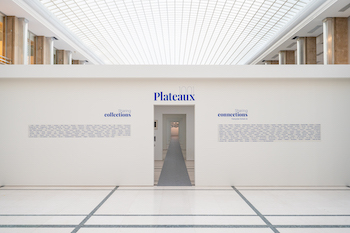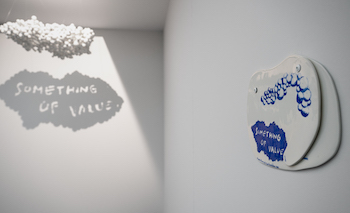The premises of Belgium’s National Bank, in the centre of Brussels, are massive – two buildings are linked by a tunnel running beneath the Boulevard de Berlaimont. So massive, in fact, that when Anne Bambynek, curator of the bank’s art collection, conducts a tour of the premises to show off the artwork scattered across the buildings’ walls and halls, it can get tiresome.
One day, when Bambynek was showing renowned Belgian artist Françoise Schein around, the two got hungry decided to head to the canteen to eat and take a break.
“That’s where the concept was formed,” Bambynek says, referring to her latest project – an exhibit involving the bank’s extensive collection of contemporary art and historic objects. “In the canteen.”
While sitting at their canteen table, Schein witnessed a daily scene: the bank’s employees flocking to lunch. Each one would come in, grab a tray, choose their food, pay, and sit down to feast. Schein decided their plates had to feature in the show somehow.
1001 Plateaux, a participatory art exhibit featuring works from the bank’s private collection accompanied by new pieces painted by current employees, opened this month and will be on display at the bank’s headquarters until 10 November.
“It’s a good way to discover how a collection works on a human scale, inside our offices,” Bambynek says. “You have this cabinet of curiosities on one side, and the interpretations of our staff on the other. It’s very down to earth, and you can cherry-pick the things you like.”
 155 employees participated in the project | Photo by Patrick van den Branden
155 employees participated in the project | Photo by Patrick van den Branden
Most large banks in the world boast their own art collections. Some, like Germany’s Deutsche Bank, even have their own exhibition space. The National Bank of Belgium began acquiring contemporary art in 1972 and has been steadily growing its collection ever since. It currently numbers about 2,000 works, roughly 80 per cent of which are in employees’ offices and throughout the building’s corridors. Every year, the bank acquires between five and 10 new works.
The collection’s official webpage says it’s a way for the institution to display “its support for the artistic creation of our country while affording its staff a unique and stimulating working environment”.
Bambynek often spends time installing new pieces, or responding to employee requests – staff can choose one artwork to be displayed in their office, with the option to change it periodically.
The art collection “is such an important part of the National Bank”, Bambynek says, “and we wanted to link the art even more with the employees”.
For the project, employees were asked to look through the bank’s illustrated catalogue and select an item from the contemporary art collection or from the bank’s museum, which displays a permanent collection dedicated to the history of currency. Then, in workshops under Schein’s guidance, they were given a white ceramic tray and asked to come up with a design to reinterpret their chosen piece.
Each of the resulting images, rendered in blue paint, represents a fusion of the employees’ viewpoint with the original piece that served as their inspiration. Schein then added one final element – a knife and a fork, in different locations on each plate, to bring it all together.
“We work in an art environment, but sometimes we don’t see it,” says Jerry Mboko Vutal, one of the bank’s account officers. “The bank is full of art actually, but when you are not used to art sometimes you don’t even see it.”
By his own admission, Mboko Vutal is not proficient in art. He couldn’t remember the last time he had touched paint. But while reluctant at first, the experience ended up feeling more personal than he had anticipated. His plateau was inspired by a work featuring a banknote, by an artist from the Congo – where Mboko Vutal is also from. “The project also made us realize this chance we have,” he adds, “to work in an environment where art is important.”
Also part of the project was independent art adviser Carine Fol, artistic director of the CENTRALE space for contemporary art in Brussels. Fol has “a really human approach to the creation of art”, Bambynek explains, and the two had been discussing collaborating on a participatory artwork project since 2019. The pandemic delayed their plans.
Over the course of 10 months, 160 employees brought the project to life. The exhibit’s title is a reference to French philosopher Gilles Deleuze’s book, A Thousand Plateaus. In it, he introduces the concept of rhizomatic thinking, which is opposed to hierarchy. For the purpose of this project, it meant that no artwork was given more importance than others.
“The first plateau you see on show is that of the first colleague who signed up for the project,” Bambynek explains, adding, with a laugh, “perhaps the most daring of them all.”
The only exception is an installation that concludes the exhibit, a work of shadow art by Flemish artist Fred Eerdekens. A shape resembling a cloud is hung from the ceiling and lit to project the words “Something of Value” on to the wall.
 Installation art by Flemish artist Fred Eerdeekens | Photo by Patrick van den Branden
Installation art by Flemish artist Fred Eerdeekens | Photo by Patrick van den Branden
Walking along the exhibit’s corridors, one recognises the names of many well-known artists. There are works by Rinus van de Velde, mostly known for his large-scale charcoal drawings, and conceptual artist Michel François. Both have recently had solo shows at the Bozar Centre for Fine Arts in Brussels.
Closer to the entrance, there is also a print of Philippe Geluck’s infamous Le Chat, a comic strip character who first appeared in the Belgian daily newspaper Le Soir four decades ago. The image features the iconic cat next to a younger feline, playing with a paper aeroplane made from a banknote. “It’s his pocket money,” the caption reads. “He can do what he wants with it.”
Siska D’hoore, the bank’s head of HR management, chose a piece that reminded her of her travels. Her plateau features a hand playing with an aeroplane – the knife included by Schein here serving as the horizon line. “As a central bank, we tend to have quite a serious image,” she says. “We’re numbers people. It’s nice to show a different side.”
Sign up to The Parliament's weekly newsletter
Every Friday our editorial team goes behind the headlines to offer insight and analysis on the key stories driving the EU agenda. Subscribe for free here.